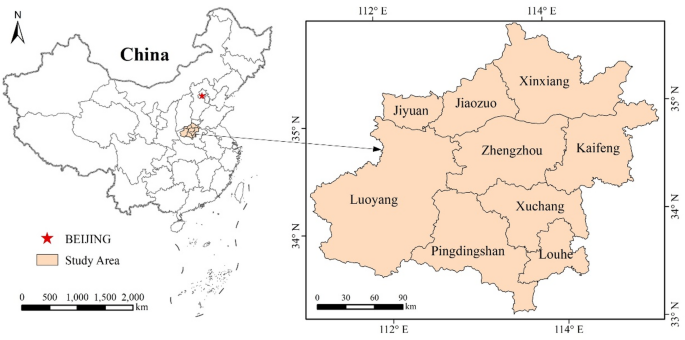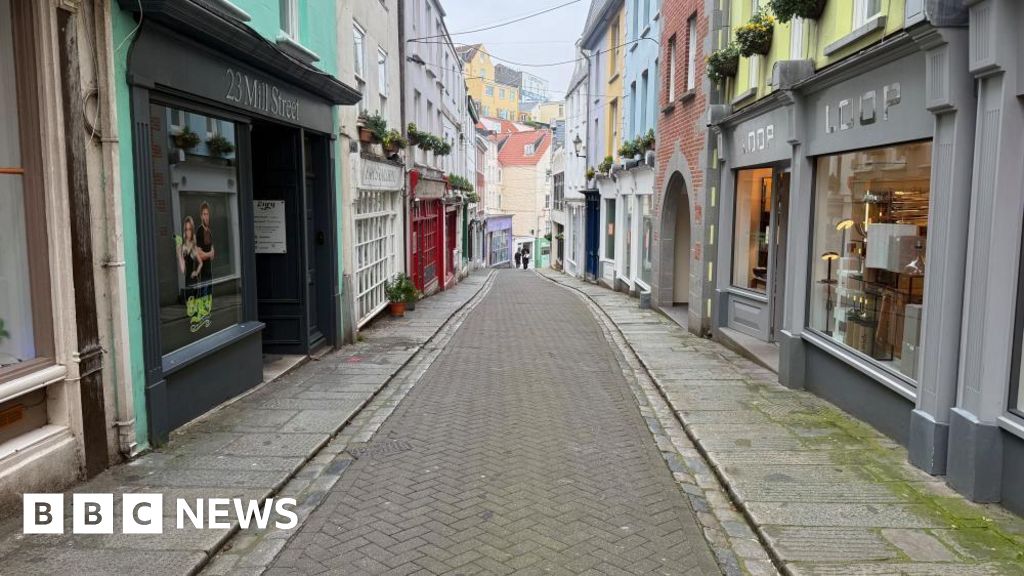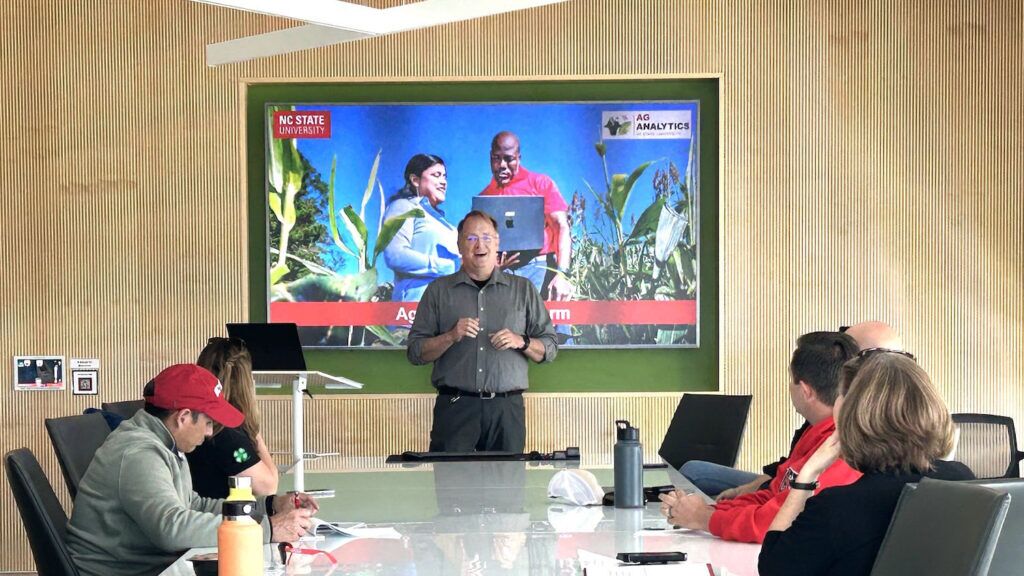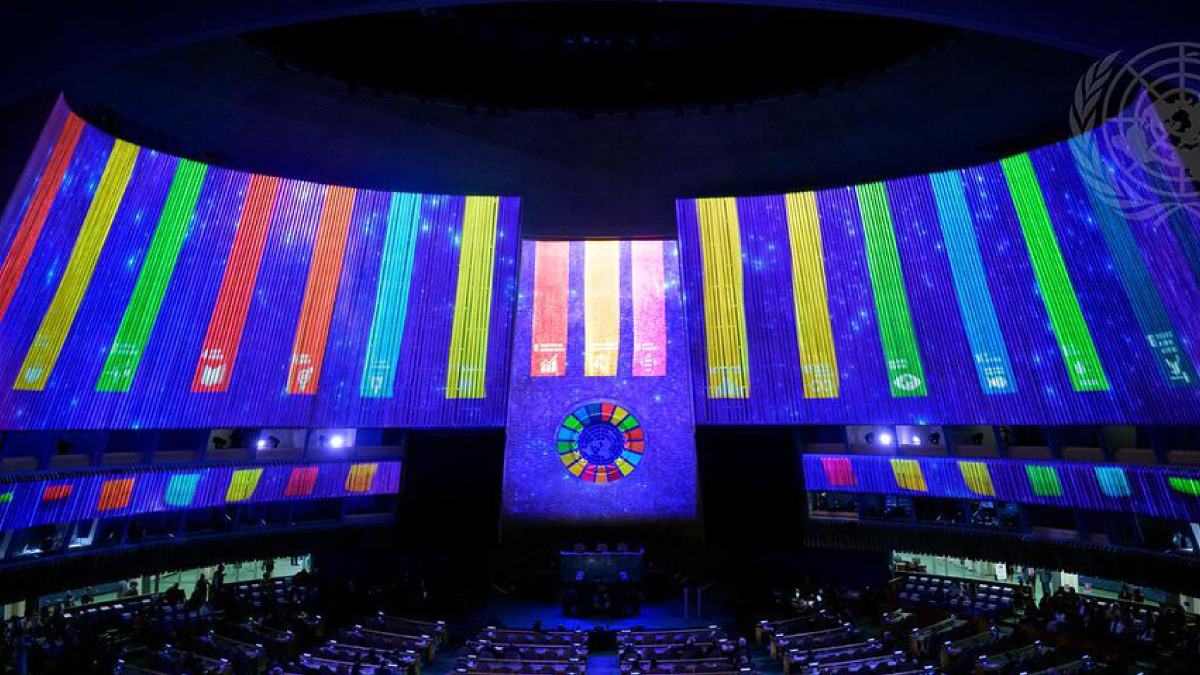Coupling and coordination mechanism and sustainable path of water resources-ecological environment-socio-economic system in Zhengzhou urban agglomeration – Nature

Executive Summary: Sustainable Development in the Zhengzhou City Cluster
This report presents an analysis of the Water-Ecological-Socioeconomic (WES) system in the Zhengzhou city cluster from 2012 to 2021, evaluating its trajectory toward achieving key Sustainable Development Goals (SDGs). The study reveals a significant improvement in the region’s overall development, with the comprehensive index rising from 0.42 to 0.78. This progress reflects advancements in SDG 8 (Decent Work and Economic Growth) and SDG 11 (Sustainable Cities and Communities). System-wide coordination has advanced from “barely coordinated” to “excellent coordination,” indicating successful policy interventions aligned with SDG 17 (Partnerships for the Goals). However, water resources remain the primary constraint, directly impacting SDG 6 (Clean Water and Sanitation) and SDG 12 (Responsible Consumption and Production). An improved Long Short-Term Memory (LSTM) model, with enhanced reliability (RMSE reduced by 20-25%), was used to simulate future scenarios. The findings suggest that differentiated regulatory strategies could accelerate coordination growth by 4-5%, providing a clear pathway for localized SDG implementation. The report concludes with targeted recommendations to advance sustainable development through differentiated strategies, enhanced resource governance, and optimized policy support, offering a replicable framework for similar urban agglomerations globally.
Introduction: Aligning Regional Development with Sustainable Development Goals
The sustainable management of water resources is fundamental to achieving the 2030 Agenda for Sustainable Development, particularly in regions facing the complex interplay between resource scarcity, ecological preservation, and socioeconomic growth. The Zhengzhou city cluster in China presents a critical case study, supporting 4.6% of the national economic output with only 1.7% of its water resources. This situation highlights the urgent need to balance SDG 8 (Decent Work and Economic Growth) with SDG 6 (Clean Water and Sanitation) and SDG 15 (Life on Land). The region’s severe water scarcity, with per capita availability at one-seventh of the national average, poses a direct challenge to SDG 11 (Sustainable Cities and Communities) and SDG 2 (Zero Hunger), given its role in national food security. This report analyzes the coupling mechanisms of the region’s Water-Ecological-Socioeconomic (WES) system to provide a framework for integrated policy-making that advances multiple SDGs simultaneously.
Research Context and Core Questions
This investigation addresses critical gaps in understanding how rapidly industrializing regions can achieve balanced growth. The core research questions are framed through the lens of the SDGs:
- Spatiotemporal Evolution: What patterns of development and coordination characterized the WES system from 2012 to 2021, and how do these reflect progress toward integrated goals like SDG 11 and SDG 17?
- Constraint Identification: Which factors within the water, ecological, and socioeconomic subsystems are the primary barriers to achieving sustainable development targets, particularly those related to SDG 6, SDG 12, and SDG 8?
- Strategic Optimization: How can predictive models and differentiated regulatory strategies be designed to accelerate the achievement of long-term, coordinated development in line with the SDGs?
Analysis of the Water-Ecological-Socioeconomic (WES) System (2012-2021)
Overall Development Trends and SDG Alignment
Between 2012 and 2021, the Zhengzhou city cluster demonstrated significant progress across all three subsystems of the WES framework, aligning with several SDG targets.
- Socioeconomic System (SDG 8 & SDG 11): The region’s GDP grew from 1.8 to 4 trillion yuan, and per capita disposable income nearly doubled. This indicates strong progress on SDG 8 (Decent Work and Economic Growth). The development of the urban cluster, led by Zhengzhou, also supports SDG 11 (Sustainable Cities and Communities).
- Water Resources System (SDG 6 & SDG 12): A notable achievement was the reduction in water consumption per 10,000 yuan of GDP from 150 m³ to 100 m³. This improvement in water-use efficiency is a direct contribution to SDG 6.4 and promotes the decoupling of economic growth from resource use, as targeted by SDG 12.2.
- Ecological Environment System (SDG 11 & SDG 15): The environmental quality index in core cities improved from 0.65 to 0.82, and industrial solid waste utilization rose to 85%. These gains reflect positive steps toward SDG 11.6 (reducing the environmental impact of cities) and SDG 15 (Life on Land).
Despite these gains, a “core-periphery” spatial differentiation persists, highlighting the need for policies that ensure equitable development across the entire region, a key principle of the 2030 Agenda.
Coupling Coordination and Progress Towards Integrated SDGs
The coupling coordination degree, which measures the synergy between the WES subsystems, evolved through three distinct phases, demonstrating the impact of targeted policy on achieving integrated sustainable development.
- Early Stage (2012–2014): The system was “barely coordinated” (0.4–0.5), indicating initial conflicts between economic ambitions (SDG 8) and environmental limits (SDG 6, SDG 15).
- Mid-Stage (2014–2018): Driven by regional development plans, coordination improved rapidly, with an average annual growth of 6.2%. This phase shows a move towards balancing different SDG priorities.
- Recent Stage (2018–2021): Following the implementation of the Yellow River Basin ecological strategy, coordination reached “high-quality” levels (exceeding 0.8), with Zhengzhou achieving 0.86 in 2021. This demonstrates a successful integration of economic, social, and environmental objectives, a core tenet of the SDGs.
The spatial analysis reveals a clear “core-periphery” gradient, with central cities showing higher coordination. This underscores the importance of regional cooperation mechanisms (SDG 17) to ensure that sustainable development benefits are shared across the entire urban agglomeration.
Key Constraints on Sustainable Development
An obstacle analysis identified the primary factors hindering the achievement of fully integrated sustainable development in the Zhengzhou city cluster.
- Water Resources as the Primary Constraint (SDG 6): Water consumption per 10,000 yuan of GDP has consistently been the main obstacle. Although its impact has diminished due to policy interventions, the region’s severe water scarcity means that efficient water management remains critical for achieving SDG 6 and ensuring the viability of all other development goals.
- Shifting Ecological and Socioeconomic Pressures (SDG 8, 9, 12): In the early period, ecological factors like low urban sewage treatment rates were significant barriers. More recently, socioeconomic constraints, such as the need for industrial restructuring (SDG 9) and optimizing economic growth models (SDG 8), have become more prominent. This reflects a transition towards addressing the complexities of responsible consumption and production (SDG 12).
Predictive Modeling and Future Scenarios for SDG Achievement
Enhanced LSTM Model for Sustainable Forecasting
To support forward-looking policy, this study developed an improved Long Short-Term Memory (LSTM) model. Traditional models often fail in small-sample scenarios and produce physically unrealistic predictions. The enhanced model addresses these flaws by:
- Embedding Physical Constraints: The model incorporates constraints such as “total water usage ratio = 100%” to ensure predictions align with real-world limits, making it a more reliable tool for planning related to SDG 6 and SDG 12.
- Improving Accuracy: Cross-validation showed the improved model reduced the root mean square error (RMSE) by 20-25% compared to traditional LSTM models, enhancing its reliability for forecasting progress towards SDG targets.
Scenario Analysis and Differentiated Regulatory Strategies
Four regulatory scenarios were simulated to forecast development until 2026 and identify optimal pathways for achieving the SDGs.
- Benchmark Scenario: Projects a slow coordination growth rate of 2.5% annually, indicating that current trends are insufficient for accelerated SDG achievement.
- Water-Socioeconomic Synergy (Targets SDG 6 & 8): This strategy boosts coordination growth by 4.8% annually in resource-based cities like Jiaozuo and Xuchang, proving effective for areas needing economic transformation alongside improved water efficiency.
- Socioeconomic-Ecological Synergy (Targets SDG 8, 9, 11): In core cities like Zhengzhou, this approach yields the highest growth of 5.2% annually, demonstrating that leveraging a strong economic base to invest in ecological quality is a powerful driver for sustainable urban development.
- Water-Ecological Synergy (Targets SDG 6 & 15): For ecologically sensitive cities, this strategy increases coordination by 4.5% annually, breaking the “resource-environment” dilemma and advancing conservation goals.
Policy Recommendations for Accelerating SDG Implementation
Differentiated Strategies for Urban Centers
To effectively localize the SDGs, tailored strategies are essential:
- Core Cities (Zhengzhou, Luoyang): Focus on “ecological-economic coupling.” This involves promoting green industrial upgrades (SDG 9), increasing the ecological water proportion (SDG 15), and leveraging smart technology for integrated monitoring (SDG 11).
- Resource-Based Cities (Jiaozuo, Xuchang): Prioritize the “dual improvement of water resources and economy.” This includes enhancing water efficiency in industry and agriculture (SDG 6, SDG 12) and supporting industrial transformation to build resilient local economies (SDG 8).
- Ecologically Sensitive Cities (Pingdingshan, Kaifeng): Strengthen “dual guarantees of water resources and ecology.” This requires strict water conservation measures and targeted ecological restoration projects to protect vital ecosystems and ensure long-term water security (SDG 6, SDG 15).
Strengthening Resource and Environmental Governance
Achieving the SDGs requires robust governance across the entire city cluster.
- Promote water-saving technologies and improve water resource management to advance SDG 6.
- Reduce industrial wastewater discharge through stricter regulations and incentives for cleaner production, supporting SDG 12.
- Increase the proportion of ecological water use to restore and maintain ecosystem health, contributing to SDG 15.
Optimizing Policy and Technological Support
Sustained progress depends on an enabling policy and technological environment.
- Advance the implementation of coordinated regional planning to ensure policy coherence, in line with SDG 17.
- Refine dynamic calibration of predictive models like the improved LSTM to provide robust decision support for policymakers.
- Establish a collaborative monitoring platform to track progress on WES system indicators and SDG targets in real-time, fostering accountability and adaptive management.
Conclusion: A Framework for Sustainable Urban Agglomerations
The analysis of the Zhengzhou city cluster from 2012 to 2021 provides a clear and evidence-based pathway for achieving sustainable development in a complex urban region. The study confirms that while significant progress has been made in balancing economic growth with environmental protection, water scarcity remains the central challenge, directly impacting the achievement of SDG 6 and constraining other goals. The success of policy interventions in improving system-wide coordination highlights the critical role of governance aligned with SDG principles. The proposed differentiated regulatory strategies, validated by an enhanced predictive model, offer a practical roadmap for accelerating progress. By tailoring policies to local conditions while strengthening regional cooperation, the Zhengzhou city cluster can serve as a model for other rapidly developing regions striving to achieve the Sustainable Development Goals.
Analysis of Sustainable Development Goals in the Article
1. Which SDGs are addressed or connected to the issues highlighted in the article?
The article on the Zhengzhou city cluster’s water resources-ecological environment-socioeconomic (WES) system addresses several Sustainable Development Goals (SDGs). The analysis of the interplay between water management, environmental quality, and economic growth directly connects to the core principles of sustainable development.
- SDG 6: Clean Water and Sanitation: This is the most central SDG in the article. The study revolves around water scarcity (“per capita water availability below 300 cubic meters”), water resource management, water use efficiency (“water consumption per 10,000 yuan GDP”), and water quality (“industrial wastewater discharge,” “centralized urban sewage treatment rate”).
- SDG 8: Decent Work and Economic Growth: The article extensively discusses socioeconomic development, including GDP growth, industrial structure (proportion of primary, secondary, and tertiary industries), and the need to decouple economic growth from resource consumption. It analyzes how water scarcity constrains economic growth and aims to find paths for “high-quality development.”
- SDG 11: Sustainable Cities and Communities: The research is focused on an urban agglomeration (the Zhengzhou city cluster). It addresses issues of regional planning, managing the environmental impact of cities (pollution, waste), and the importance of green infrastructure (“green coverage rate in built-up areas”). The goal of achieving “coordinated development” within the city cluster is a key theme.
- SDG 12: Responsible Consumption and Production: The article’s emphasis on improving water resource utilization efficiency and reducing industrial wastewater discharge directly relates to promoting sustainable production patterns. The analysis of “water consumption per 10,000 yuan of GDP” is a key metric for measuring the efficiency of resource use in production.
- SDG 15: Life on Land: The ecological dimension of the WES system connects to this goal. The article discusses the importance of ecological conservation, ecological restoration, and maintaining ecological stability. It specifically mentions allocating water for ecological purposes (“ecological water use ratio”) and increasing green spaces, which are crucial for terrestrial ecosystems.
- SDG 17: Partnerships for the Goals: The study highlights the critical role of policy coherence and effective governance in achieving sustainable development. It mentions specific policies like the “Central Plains City Cluster Development Plan” and the “Yellow River Basin Ecological Protection and High-Quality Development Strategy.” The recommendation to establish a “collaborative monitoring platform” also points towards strengthening partnerships and institutional capacity.
2. What specific targets under those SDGs can be identified based on the article’s content?
Based on the issues and solutions discussed, several specific SDG targets can be identified:
- Under SDG 6:
- Target 6.3: By 2030, improve water quality by reducing pollution, eliminating dumping and minimizing release of hazardous chemicals and materials, halving the proportion of untreated wastewater and substantially increasing recycling and safe reuse globally. The article directly addresses this by analyzing “industrial wastewater discharge” and the “centralized treatment rate of urban sewage.”
- Target 6.4: By 2030, substantially increase water-use efficiency across all sectors and ensure sustainable withdrawals and supply of freshwater to address water scarcity. The study’s focus on reducing “water consumption per 10,000 yuan of GDP” and managing a “severely water-scarce area” is a direct link to this target.
- Target 6.5: By 2030, implement integrated water resources management at all levels, including through transboundary cooperation as appropriate. The article’s WES system framework is a model for integrated management, and its analysis at the city cluster level reflects management across different administrative units.
- Under SDG 8:
- Target 8.4: Improve progressively, through 2030, global resource efficiency in consumption and production and endeavour to decouple economic growth from environmental degradation. The entire premise of the study—balancing economic growth with water and ecological constraints—is aligned with this target. The metric “GDP output per unit of water resources” is a direct measure of this decoupling.
- Under SDG 11:
- Target 11.3: By 2030, enhance inclusive and sustainable urbanization and capacity for participatory, integrated and sustainable human settlement planning and management in all countries. The article’s analysis of the “core-periphery” structure of the Zhengzhou city cluster and its proposal for “differentiated regulatory strategies” for different cities directly relates to sustainable urban planning and management.
- Target 11.6: By 2030, reduce the adverse per capita environmental impact of cities, including by paying special attention to air quality and municipal and other waste management. The study includes indicators like “industrial sulfur dioxide emissions,” “industrial smoke/dust emissions,” and “industrial wastewater discharge” to measure the environmental impact of cities.
- Target 11.a: Support positive economic, social and environmental links between urban, peri-urban and rural areas by strengthening national and regional development planning. The focus on a city cluster and the mention of policies like the “Zhongyuan City Cluster Development Plan” directly address the need for coordinated regional planning.
- Under SDG 12:
- Target 12.2: By 2030, achieve the sustainable management and efficient use of natural resources. The article’s core theme of improving the efficiency of water resources, a key natural resource, directly supports this target.
- Under SDG 15:
- Target 15.1: By 2020, ensure the conservation, restoration and sustainable use of terrestrial and inland freshwater ecosystems and their services. The study’s inclusion of the “ecological environment system” and indicators like “ecological water ratio” and “green coverage rate” highlights the importance of protecting and restoring ecosystems within the urban agglomeration.
- Under SDG 17:
- Target 17.14: Enhance policy coherence for sustainable development. The article demonstrates how different policies (“strictest water resource management system,” “Blue Sky Defense War”) have influenced the WES system, and its proposal for differentiated strategies is an attempt to create more coherent policies for sustainable development.
3. Are there any indicators mentioned or implied in the article that can be used to measure progress towards the identified targets?
Yes, the article is rich with specific quantitative indicators used in its evaluation framework, which can directly serve as metrics for measuring progress towards the identified SDG targets.
- For Target 6.3 (Water Quality):
- Industrial wastewater discharge volume (A22): A direct measure of pollution from industrial sources.
- Centralized urban sewage treatment rate (A17): Measures the proportion of wastewater that is treated, directly tracking progress on reducing untreated wastewater.
- For Target 6.4 (Water-Use Efficiency):
- Water consumption per 10,000 yuan GDP (A15): A key indicator of water efficiency in the economy.
- Per capita water usage (A14): Measures water consumption at the individual level.
- Agricultural/industrial/lifestyle water usage ratios (A4/A5/A8): Shows how water is allocated and consumed across different sectors.
- For Target 8.4 (Resource Efficiency):
- GDP total (A3) and Water consumption per 10,000 yuan GDP (A15): Used together, these indicators can show whether economic growth is decoupling from water consumption.
- Ratio of primary/secondary/tertiary industries (A1/A2/A9): Tracks the shift towards less resource-intensive economic activities.
- For Target 11.6 (Urban Environmental Impact):
- Industrial sulfur dioxide emissions (A23): An indicator for air pollution.
- Industrial smoke/dust emissions (A24): Another indicator for air pollution.
- Industrial wastewater discharge volume (A22): An indicator for water pollution caused by cities.
- For Target 15.1 (Ecosystem Health):
- Ecological water ratio (A20): Measures the proportion of water allocated specifically for maintaining ecosystem health.
- Green coverage rate in built-up areas (A18): An indicator of the extent of green spaces and urban ecosystems.
4. Table of SDGs, Targets, and Indicators
| SDGs | Targets | Indicators Identified in the Article |
|---|---|---|
| SDG 6: Clean Water and Sanitation | 6.3: Improve water quality and reduce pollution. 6.4: Increase water-use efficiency and address water scarcity. 6.5: Implement integrated water resources management. |
|
| SDG 8: Decent Work and Economic Growth | 8.4: Improve resource efficiency and decouple growth from environmental degradation. |
|
| SDG 11: Sustainable Cities and Communities | 11.3: Enhance sustainable urbanization and planning. 11.6: Reduce the environmental impact of cities. 11.a: Strengthen regional development planning. |
|
| SDG 12: Responsible Consumption and Production | 12.2: Achieve sustainable management and efficient use of natural resources. |
|
| SDG 15: Life on Land | 15.1: Ensure conservation and restoration of freshwater ecosystems. |
|
| SDG 17: Partnerships for the Goals | 17.14: Enhance policy coherence for sustainable development. |
|
Source: nature.com
What is Your Reaction?
 Like
0
Like
0
 Dislike
0
Dislike
0
 Love
0
Love
0
 Funny
0
Funny
0
 Angry
0
Angry
0
 Sad
0
Sad
0
 Wow
0
Wow
0



















































.jpg.webp?itok=0ZsAnae9#)
























